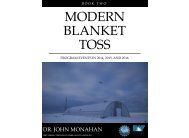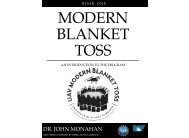Modern Blanket Toss: Findings and Observations
This book is the last in a series of three covering the National Science Foundation awarded Modern Blanket Toss project. In this book are the evaluation findings for each of the three years as well as observations from Modern Blanket Toss staff.
This book is the last in a series of three covering the National Science Foundation awarded Modern Blanket Toss project. In this book are the evaluation findings for each of the three years as well as observations from Modern Blanket Toss staff.
You also want an ePaper? Increase the reach of your titles
YUMPU automatically turns print PDFs into web optimized ePapers that Google loves.
2016 FINDINGS<br />
Table 17. Average survey responses to content items from first to last<br />
survey.<br />
First<br />
Survey<br />
Note: Average is the average of Likert scales responses from 1 to 10.<br />
Last<br />
Survey<br />
Change<br />
How to use GIS mapping software 1.53 4.37 2.84<br />
The safety rules <strong>and</strong> regulations that apply to<br />
flying a UAV<br />
How to acquire different types of data using<br />
UAVs<br />
How to use data collected to develop a map/<br />
image that represents reality<br />
The amount of money students can earn from a science,<br />
technology, engineering or math career<br />
4.21 6.95 2.74<br />
2.28 4.96 2.68<br />
2.51 5.14 2.63<br />
4.23 6.75 2.53<br />
How to ask questions using GIS software 2 4.4 2.4<br />
How to build a UAV 3.02 5.34 2.32<br />
Applications of UAV technology 3.21 5.49 2.28<br />
How to fly a UAV 3.61 5.7 2.09<br />
How to acquire data from databases 2.46 4.51 2.05<br />
The range of science, technology, engineering <strong>and</strong> math<br />
careers that are available to students<br />
4.14 6.18 2.04<br />
Principles of flight (e.g., lift, drag, gravity) 4.11 5.81 1.7<br />
The level of math <strong>and</strong> science students will need for various<br />
science, technology, engineering, <strong>and</strong> math careers<br />
4.35 6.02 1.67<br />
How to use a 3-D printer 2.25 3.74 1.49<br />
Science content included principles of flight (e.g., lift, drag, gravity), safety rules<br />
<strong>and</strong> regulations that apply to flying a UAV, <strong>and</strong> applications of UAV technology.<br />
Students reported the greatest content gains in 1) how to use GIS mapping<br />
software, 2) how to acquire different types of data using UAVs, 3) how to use<br />
data collected to develop a map/image that represents reality, <strong>and</strong> 4) the<br />
safety rules <strong>and</strong> regulations that apply to flying a UAV. These results are<br />
illustrated in Table 17.<br />
Science practices included topics such as<br />
asking scientific questions, comparing<br />
data to other students’ data, <strong>and</strong><br />
explaining patterns in scientific data.<br />
Students reported the greatest gains in<br />
underst<strong>and</strong>ing of science practices in four<br />
areas: 1) asking a new scientific question<br />
from data, 2) formulating <strong>and</strong> refining<br />
experimental questions, 3)<br />
communicating the results of data<br />
analysis to a broader audience, <strong>and</strong> 4)<br />
using a map to analyze scientific data.<br />
These results are illustrated in Table 18.<br />
In interviews, students reported learning<br />
about UAVs <strong>and</strong> mapping, especially<br />
speaking confidently about data<br />
collection <strong>and</strong> learning new software. For<br />
example:<br />
I have learned a lot. I know how<br />
to, like I have learned the basics<br />
of mission planning. I’ve learned<br />
a lot with computers that I don’t<br />
know, like, right now I'm making<br />
a map, a 50 photos map.<br />
[2016:3:6]<br />
Table 18. Average survey response<br />
last survey.<br />
Science Practice Area<br />
I am capable of using a map to analyz<br />
scientific data.<br />
I am capable of asking a new scientific<br />
from data that I have collected.<br />
I can communicate the results of my d<br />
analysis to a broader audience.<br />
I can formulate <strong>and</strong> refine experimen<br />
questions.<br />
I can explain patterns in scientific data.<br />
I can analyze scientific data in many different w<br />
I can select tools to gather data.<br />
I am capable of deciding what data are to be ga<br />
answer a question.<br />
I can compare my data to other students’ data.<br />
I can study data with the help of maps.<br />
I can make <strong>and</strong> use a model to test a design.<br />
Note: Average is the average of Likert scales res<br />
49




